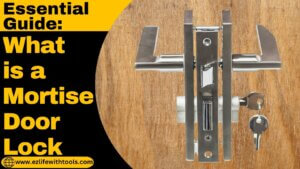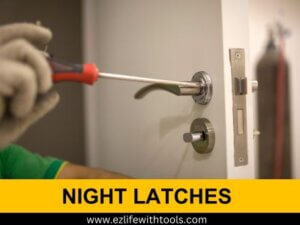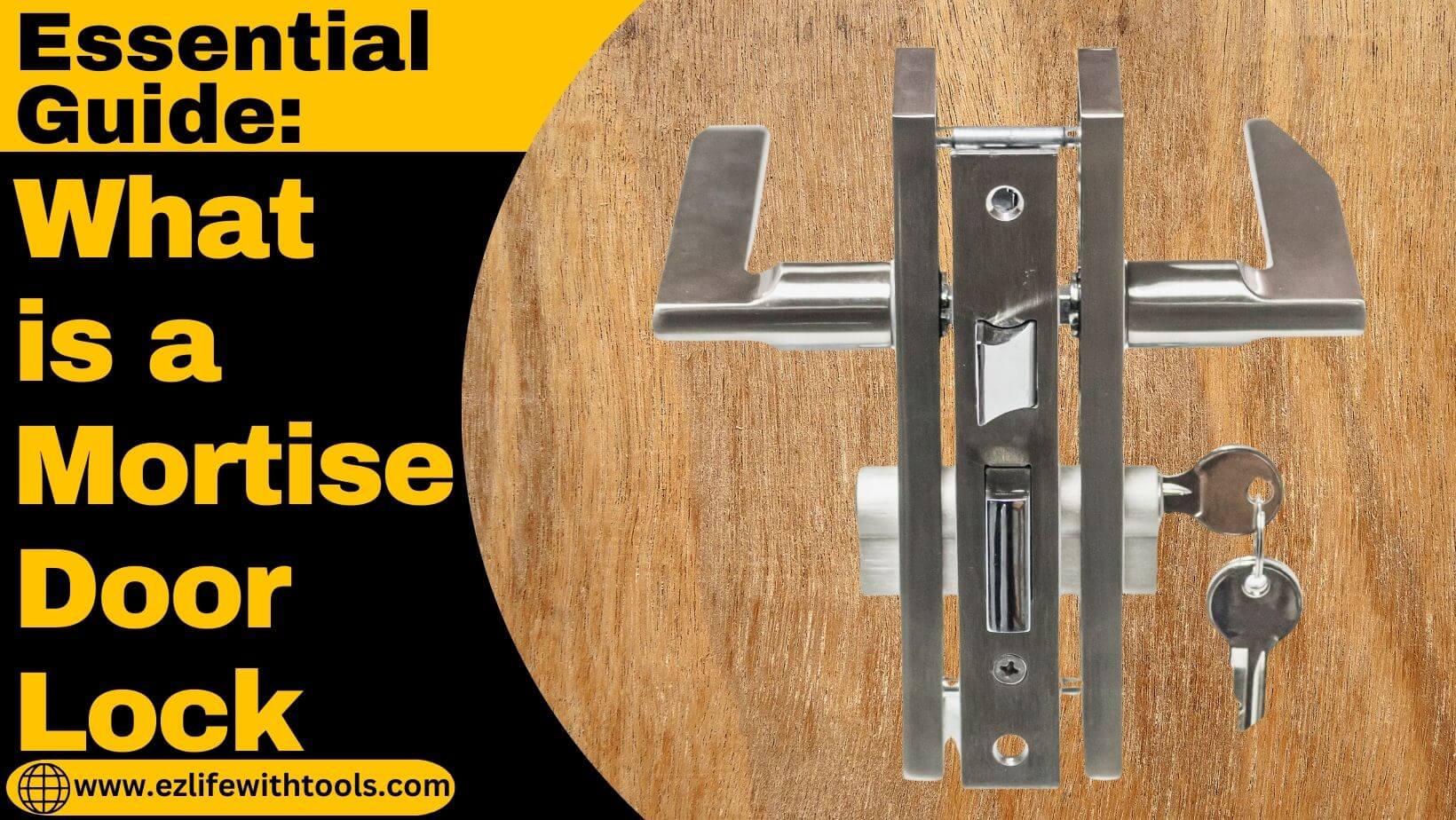Essential Guide: What Is a Mortise Door Lock and How It Work
Mortise door locks are a hidden and robust mechanism that has secured homes and commercial spaces for

centuries. It is a perfect choice in the security requirement areas due to its complex mechanism to fulfill all the security needs.
It isn’t easy to summarize in a few words, so it requires a detailed explanation. It will help you to understand their inner workings, types, installation process, and advantages to choose the right mortise lock according to your needs.
So, stay with me to understand what is a mortise door lock and all necessary steps.
What is a Mortise Door Lock? (Definition)
A mortise door lock is a robust security mechanism installed inside the door. It uses a pocket (mortise) cut into the door edge for its components, offering a strong and durable locking mechanism.
History and Evolution
Understanding the history and evolution of mortise locks describes their importance, development, and relevance in different periods. Let’s explain in detail.
Mortise locks have their origins in ancient civilizations, with evidence of similar methods found in ancient Egypt, Greece, and Rome. Advancement in lock manufacturing during the Middle Ages led to more sophisticated designs, and skilled artisans created complex mechanisms for security purposes.
The revolution of industries also played a vital role in manufacturing, which made mass production of mortise locks possible and made them more accessible.
Not only security but also their designs and finishes are created according to the different architectural styles and aesthetic preferences.
The adaption of different architectural styles makes it an integral part of building design across cultures and periods.
Mortise locks have various types and designs; each design fulfills the specific security needs according to the diverse door types.
Understanding the differences between these variations helps users to choose the most suitable mortise lock for their space.
Differences Between Traditional and Modern Mortise Locks
There is no vast difference between traditional and modern mortise locks.
Traditional mortise lock manufacturers only follow time-tested designs and functionalities, offering reliability and security.
But modern variations, like electric locks, integrate advanced technology for remote access and additional control, catering to evolving security needs.
Different Types of Mortise Locks
Dead latch: This type of latch mechanism is commonly found in door locks. It automatically locks when the door is closed and requires a key or knob to retract the latch bolt.
- Deadlocks
- Night Latches
- Electric Locks
1- Deadlocks
Security locks that provide enhanced protection by requiring a key or knob to operate both the latch and the deadbolt, making it difficult for intruders to bypass.

2- Night Latches
A type of auxiliary lock often used in addition to the primary lock on doors. They automatically lock when the door is closed and can be opened from the inside with a knob or lever.

3- Electric Locks
Locking mechanisms operated by electricity, commonly used in access control systems. They can be unlocked using a keypad, card reader, biometric scanner, or remotely through electronic signals.

How to Choose the Right Mortise Lock for Different Doors
Choosing the right mortise lock involves considering multiple factors. Following these factors will help you to select the appropriate type of lock.
Door Type
Every building has different types of doors, and all the doors require varying levels of security. Because residential, commercial, or specialized doors require specific types of mortise locks. So, always remember the kind and building of the door and then choose the appropriate mortise lock.
Security Level
Always assess the level of security required. High-security areas might need more robust mortise locks with additional features.
Durability and Material
Evaluate the durability of the lock and its resistance to wear and tear. Choose locks made from sturdy materials for long-term reliability.
Compatibility with Access Control
Consider the compatibility of the lock with access control systems if remote access and advanced security are desired.
Where and Why to Use Mortise Locks
Those homeowners who are seeking robust security can use mortise locks to secure residential entry doors. Mortise locks can be used to secure offices, warehouses, and commercial establishments where higher security measures are essential.
How to Install a Mortise Door Lock in a New Door
Installing a mortise lock involves a step-by-step process that ensures proper functionality and safety. First, we should understand how mortise locks work and what their components are; it will help us install them better.
- Components of Mortise Lock
- Required Tools
- Installation Process
1- Components of Mortise Lock
Understanding the components of a mortise lock helps with both installation and maintenance.
- Lock Body: This is the main outer part of the lock, which houses all the mechanisms.
- Latch and Deadbolt: It is an extending and retracting component of the lock to secure the door.
- Strike Plate: It is a metal plate on the door frame, where the latch or bolt secures the door and is called the strike plate.
- Lock cylinder: The part where the key is inserted to engage the locking mechanism.
- Escutcheon Plates: Decorative or protective plates around keyholes and cylinders called escutcheon plates.
2- Required Tool
Before initiating the installation process, gather the necessary tools and ensure the door is prepared for the installation.
- Flathead Screwdriver
- Philip-head Screwdriver
- Power Drill
- Pencil
- Chisel
- Measuring Tape
- Mallet
- Clamps
- Door Lock installation kit
Installation Process
The installation of a mortise lock requires precision and attention. The installation generally involves the following steps:
- Measure out the mortise pocket in the door edge.
- Make a deep pocket with the help of a chisel to accommodate the lock body.
- Place the lock body within the mortise pocket.
- Align the body lock properly with the door and frame and make sure that it fits easily and securely.
- Fix the strike plate onto the door frame.
- Make sure the strike plate aligns perfectly with the lock body for a secure latch.
- Insert the lock cylinder into the body of the lock and secure it with the provided screws.
- Operate the lock multiple times with the key to ensure smooth functionality.
- Check the alignment and adjust if necessary.
- Now, your mortise lock is ready to work.
Unlocking and Access Control
Unlocking a mortise lock involves various methods, like traditional essential operation and modern access control systems. Understanding these methods and the mechanisms behind them is necessary for efficient operation and security.
Mortise locks can be integrated with access control systems, which will help to allow for advanced methods of unlocking and securing premises.
There are three basic unlocking methods with access control systems.
- Keycards or Fobs
- Keypad Entry
- Biometric Scanning
1- Keycards or Fobs
In this method, users can unlock the mortise lock by using a keycard or fob with the authorized credentials.
2- Keypad Entry
This method provides an option to Input a unique code with the help of a keypad, which grants access, eliminating the need for physical keys.
3- Biometric Scanning
It is the most advanced method for secure and convenient access control. You can use fingerprints or other biometric data to unlock it.
Note: Understanding the integration of these advanced methods with mortise locks provides users with versatile and efficient ways to manage access and security.
Advantages and Disadvantages
Everything has advantages and disadvantages. The mortise locks also follow the same rule.
Understanding both can help you to choose the right mortise lock according to your needs.
Advantages
- Mortise locks provide robust security due to their internal mechanism and installation within the door.
- Mortise locks offer increased resistance against forced entry.
- They are known for their durability.
- The sturdy material is used to make mortise locks.
- Mortise locks are available in various designs and finishes.
Disadvantages
- Installing mortise locks requires more expertise and precision than surface-mounted locks.
- Mortise locks are relatively more expensive than standard locks.
Conclusion
Understanding the properties of a mortise door lock is essential in providing security and functionality to residential and commercial spaces. Its time-tested design and durable mechanism within the door provide enhanced strength and reliability, which make it a preferred choice for all.
The different types of mortise locks’ complicated but solid structures, compatible with various door types, illustrate their versatility and effectiveness in safeguarding properties.
After a detailed discussion about mortise door locks, their different types, selection, and the installation process, I am confident that you also have the confidence to choose and install the right mortise lock according to your needs.
Thank you for your precious time and trust.
Best wishes

